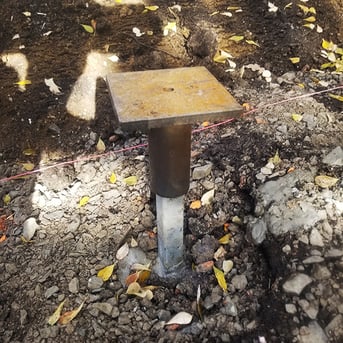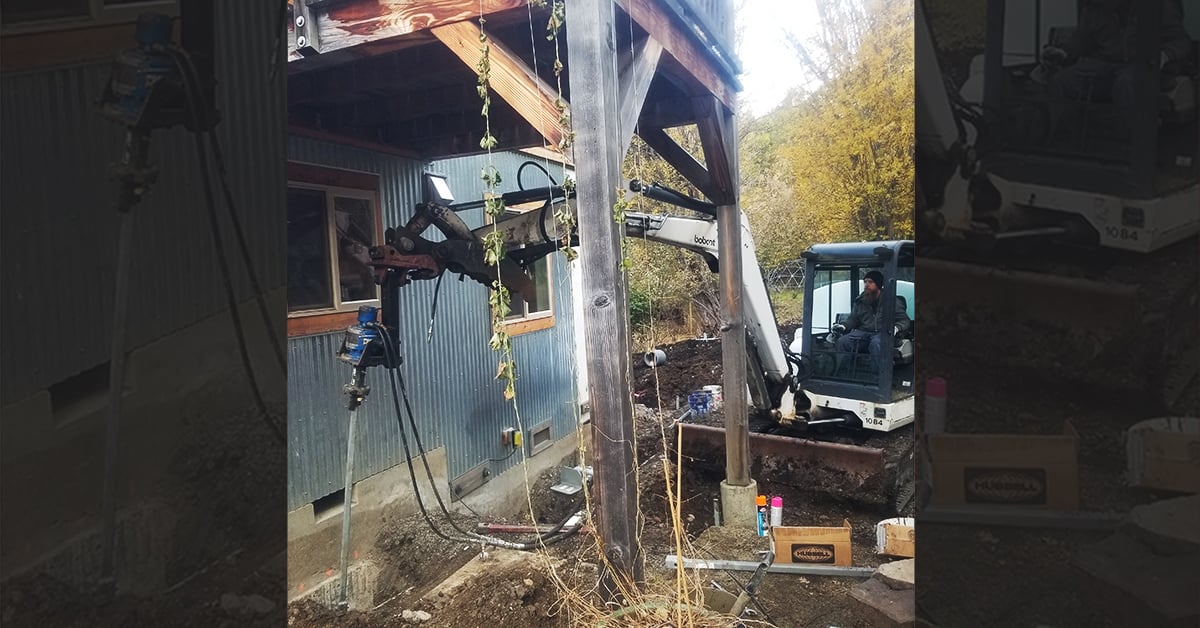Ashland sits in the foothills of the Siskiyou and Cascade mountain ranges in southwest Oregon. A remedial repair on a 10-year-old, 2-story home was needed, along with new construction piles for an addition being built.
In its 10 years, the home had already settled well over an inch. The homeowner wanted to shore up the existing home and ensure his new construction addition was on a solid foundation, rather than having to face inevitable repairs down the road. The problem encountered was the initial helical piles did not hit sufficient torque until around 50 feet of depth. Torque measured during helical pile installation indicates capacity, so ensuring the required torque was reached was crucial. If a 50-foot depth for the piles would have been the only option, the cost of the project would have been out of reach for the homeowner.
But, like any engineer, I love a good design challenge. Our team at R.A. Murphy Construction did not give up! With the piles going so deep before reaching sufficient torque, we explored other options. Chance® Helical Pulldown® Micropiles seemed to be a good solution.
What’s a Pulldown Micropile?
The Chance Helical Pulldown Micropile (HPM) is a deep foundation solution that constructs a grout column around the shaft of a standard helical pile foundation system. This time and labor saving product is installed directly into soil eliminating the need for excavation and spoil removal from the jobsite, allowing for 40-50 piles to be installed per day with smaller crews and equipment. The result is a helical pile with grouted shaft similar, in terms of installation, to drilled and grouted anchors or auger cast-in-place piles using gravity grouting.
The unique design combines both end-bearing on the helical plates and side resistance along the rough surface of the grout column, which results in a higher capacity pile system that is excellent for weak soil sites with limited access.
Learn more about Helical Pulldown Micropiles in this video:
Job Site Challenges
The two biggest challenges on this job site were the soil and limited access – making this job a perfect fit for the Pulldown Micropiles.
The soil was a black, sticky clay with heavy shrink/swell potential. This soil type contributed to the need for repair on the original foundation after only ten years and to the low torque measurements when the helical piles were initially installed without a grout column.
Limited access was also a challenge. A couple of the piles had to be installed through an interior floor with limited access for the installation equipment. The new construction piles for the addition were limited by an already prepared footing bed for the addition’s new grade beam which would sit atop the Helical Micropiles.
Helical Piles vs. Push Piers
The existing two-story home had a footing engineered for a larger three-story building. Helical piles were chosen over hydraulically driven push piers because helical pile would provide more capacity than push piers . However, as discussed, upon initial installation, the soft clay layer required an even more stout solution. By adding the grout column around the square shaft (SS) helical piles, the side resistance due to skin friction along the shaft increased the pile capacity.
Installation
 Using a 337 Bobcat Mini Excavator with an Eskridge 7k drill head attachment, (6) SS5 helical piles installed for remedial repair of the existing structure without a grout column varying from 45 – 51 feet. (28) SS5 Helical Micropiles with grout columns were installed between 7-10 feet with a few varying from 21-29 feet.
Using a 337 Bobcat Mini Excavator with an Eskridge 7k drill head attachment, (6) SS5 helical piles installed for remedial repair of the existing structure without a grout column varying from 45 – 51 feet. (28) SS5 Helical Micropiles with grout columns were installed between 7-10 feet with a few varying from 21-29 feet.
The target torque was primarily 4,300 ft /lb with a maximum depth of 30 ft. Almost all of the Helical Pulldown Micropiles met or exceeded the torque installation target well before the maximum depth requirement of 30 feet.
Torque was measured during installation using hydraulic pressure measurements and conversion to torque.
Once the decision was made to move forward with grouting the helical piles, installation was quick. With 5 people crew, we installed and bracketed (27) Helical Pulldown Micropiles in 2 days.

Key Benefits
The benefit of helical piles is that they extend below the poor soil layer allowing the helical pile foundation to tip into solid stratum. The added benefit of the grout column installed via Helical Pulldown Micropiles is the skin friction which quickly increased the overall capacity.
Once we transitioned the job to the grouted Helical Pulldown Micropiles, the owner was surprised and pleased how fast we were able to get them installed.
Whether you are considering the best start for your home’s new foundation, or need to repair a failing foundation, contact your local Chance distributor. Our engineers and installers will work with you and your specific site conditions until the best solution is found to get you back on solid ground.


